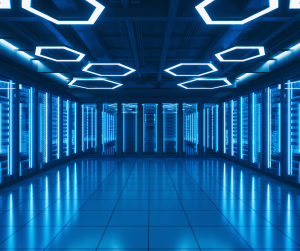Every click, swipe, or tap generates data that needs a home, datacenters emerge as the unsung heroes behind the scenes. Imagine a vast sanctuary that holds the key to your virtual life, a fortress where your precious data finds solace and protection, awaiting your beck and call. Welcome to the enigmatic world of datacenters, the heartbeat of our interconnected existence. As we venture into the depths of these colossal structures, we unveil a realm shrouded in mystery yet pivotal for the functioning of our modern society. The term “datacenter” may sound mundane, but beneath its surface lies a labyrinth of servers, cables, and cooling systems working tirelessly to safeguard and process the digital footprint of humanity. Join us on this journey of discovery as we peel back the layers of complexity surrounding datacenters, revealing the hidden intricacies that make them the beating heart of our information age.
The Evolution of Datacenters: From Humble Beginnings to Technological Marvels
Datacenters have come a long way since their humble beginnings. In the early days, datacenters were nothing more than small rooms filled with rows of servers, often located in basements or nondescript buildings. These early datacenters were primarily used by large corporations and government agencies to store and process data.
However, as technology advanced and the demand for data storage and processing increased, datacenters evolved into massive facilities capable of housing thousands, if not millions, of servers. Today’s datacenters are marvels of engineering, with state-of-the-art cooling systems, redundant power supplies, and advanced security measures.
One of the key drivers behind the evolution of datacenters is the exponential growth in data generation. With the rise of social media, e-commerce, and cloud computing, the amount of digital information being created and consumed has skyrocketed. This has led to a need for larger and more efficient data storage and processing facilities.
Another factor contributing to the evolution of datacenters is the increasing demand for real-time access to information. In today’s fast-paced world, businesses rely on instant access to their data to make critical decisions. This has led to the development of edge computing, where smaller datacenters are located closer to end-users to reduce latency and improve performance.
Location Matters: Unraveling the Mystery Behind Datacenter Sites
The location of a datacenter plays a crucial role in its overall performance and efficiency. When choosing a site for a new datacenter, several factors need to be considered.
Firstly, proximity to major network hubs is essential for ensuring fast and reliable connectivity. Datacenters located near these hubs can benefit from high-speed internet connections and low latency.
Secondly, the availability of reliable power sources is crucial. Datacenters consume vast amounts of electricity to power and cool their servers. Therefore, being located in an area with a stable power grid and access to renewable energy sources can significantly reduce operating costs and environmental impact.
Lastly, the geographical location should also take into account natural disaster risks. Datacenters need to be built in areas that are less prone to earthquakes, floods, or other potential hazards.
Power Play: Understanding the Energy Demands of Datacenters
Datacenters are notorious for their high energy consumption. The sheer number of servers and cooling systems required to keep them running 24/7 results in massive electricity bills and a significant carbon footprint.
To address this issue, datacenter operators are increasingly adopting sustainable practices to reduce their energy consumption. One such practice is virtualization, where multiple virtual servers run on a single physical server, reducing the overall hardware requirements.
Datacenter operators are also investing in more energy-efficient cooling systems. Traditional air conditioning units are being replaced with advanced cooling technologies such as liquid cooling and free-air cooling, which can significantly reduce energy consumption.
In addition to these measures, datacenter operators are exploring renewable energy sources such as solar and wind power to meet their electricity needs. By harnessing clean energy, datacenters can minimize their environmental impact while still meeting the growing demand for data storage and processing.
Sustainable Practices: Green Initiatives in Datacenter Management
The push for sustainability extends beyond just reducing energy consumption in datacenters. Many operators are implementing green initiatives throughout the entire lifecycle of a datacenter.
During the construction phase, sustainable building materials and techniques are being used to minimize waste and maximize energy efficiency. For example, datacenters are designed with optimal insulation to reduce heat loss and improve energy efficiency.
Once operational, datacenters are implementing recycling programs to minimize electronic waste. Servers and other equipment that have reached the end of their lifecycle are responsibly disposed of or refurbished for reuse.
Datacenter operators are also exploring innovative ways to repurpose waste heat generated by servers. This heat can be used to warm nearby buildings or even generate electricity, further reducing the environmental impact of datacenters.
Closing Thoughts: Decoding the Significance of Datacenters in Our Digital World
Datacenters play a vital role in our increasingly digital world. They serve as the backbone of our interconnected society, enabling us to store, process, and access vast amounts of information with ease.
From their humble beginnings as small server rooms to the technological marvels they are today, datacenters have evolved to meet the ever-growing demands of our digital age. They have become more efficient, sustainable, and secure, ensuring that our data remains safe and accessible at all times.
As we continue to rely on technology for every aspect of our lives, the importance of datacenters will only continue to grow. They are not just warehouses for data; they are the guardians of our virtual lives, providing us with the infrastructure needed to navigate and thrive in an increasingly connected world.
TurnKey Hosting offers diverse web hosting services, including cPanel, cloud, dedicated servers, and VPS, all backed by cutting-edge datacenter technology. We provide secure, scalable, and customizable hosting solutions for any online need.


